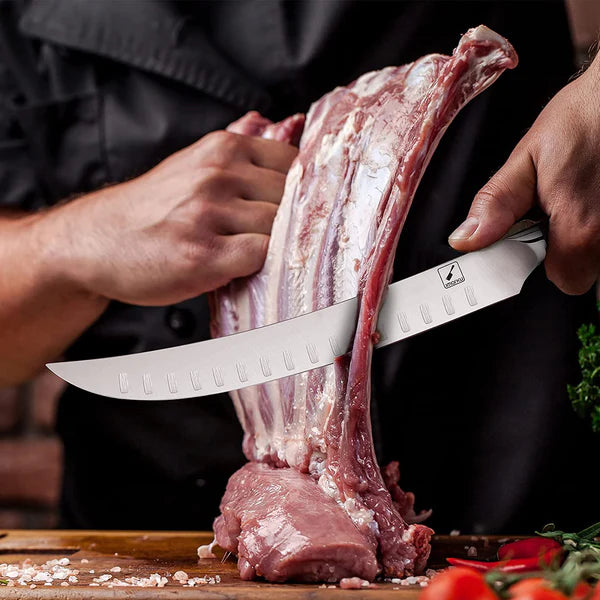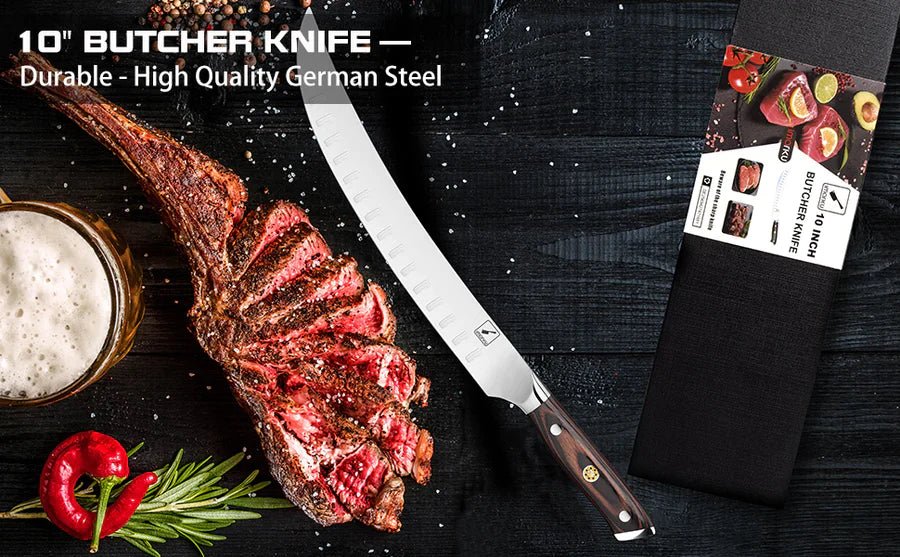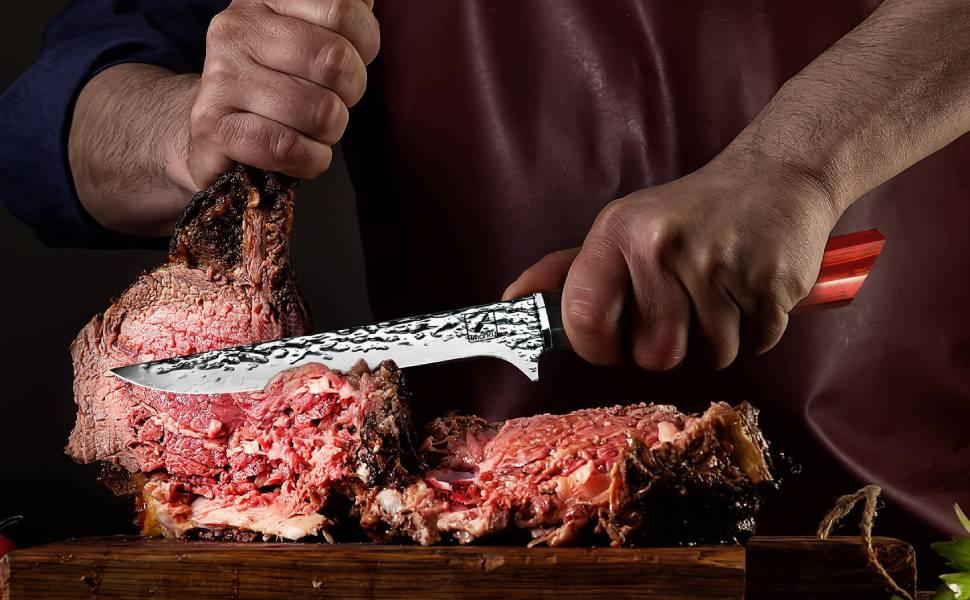TABLE OF CONTENTS
Every kitchen should have at least one scimitar knife that can be used for a wide range of tasks, from cutting to butchering. If you have the right blade, you'll be able to cut more precisely, making cooking much easier and more fun.
One of the essential knives in the kitchen is the scimitar, which is a big butcher knife with a curved blade. Even though a regular kitchen knife can be used to cut slabs of meat or dress dead animals, the scimitar or butcher knife will be your best friend in this scenario. You would like it more if you knew how valuable the scimitar knife was and how many things you could do with it. This post will get more details about the cimeter knife uses, so keep reading!

What is a Scimitar Knife?
Scimitars, also called "cimeter knives" because of the shape of their blades, are great for cutting through a wide range of meats, such as beef, pork, chicken, fish, and more. When more precise cutting is needed, like when trimming the brisket, sirloin, or shank, the blade is bent, and the tip is sharpened. You should include a caliper knife in your set of knives because it is an essential tool.
There are many differences between a regular kitchen knife and a scimitar kitchen knife. Since it was made with high-quality steel, it always cuts clean slices of meat. Even though the blade is sharp like a razor, it is much stronger than the blades of other knives. It's meant for professional chefs, butchers, and hunters but may be used in a home kitchen.
During production, the knife was given a tapering shape to make it look better and ensure it would be flexible and last long. When it comes to the handle, wood is the most common material because it feels more sociable and is easier to control.
History of the Scimitar Knife
There is evidence that people were using scimitars as early as the 9th century. Most likely, Turkic troops from central Asia were the ones who brought the curved shape of the scimitar to central Islamic parts of the world at some point in history. During the time of the Ottoman Empire, it became at least more popular in the whole Middle East. Arabs and Persians both used swords with straight blades in the past.
The fact that Turkic cavalry used scimitars made an indelible mark, especially after the Mongol invasions of the 13th century. The scimitar made it to Eastern Europe by going through Russia and Ukraine. It got a new name in Russian, Hungarian, Polish, German, French, and English. The new terms were sablya, szabla, sabel, and saber. The word was said to be szabla in Polish.
What Is a Scimitar Knife Used For?
The scimitar knife was used for cutting through large portions of food. Since the blade on these knives is curved, it is easy to cut through large pieces of meat, get under the skin, and go around the bones. Since these blades will be used hard, the steel used to make them has to be very high quality.
So, scimitar knives, also called cimeter knives, have a sharp edge like a razor, are very strong, and don't break easily. At the very least, they should be all of these things. Many of the so-called scimitar knives on the market today are weaker than they should be if they do the job right.
How to Use a Scimitar Knife
The scimitar knife used to cut thin slices of meat or large pieces of meat, depending on what needs to be done. It can also be used to remove sinews from meat. As you move the knife along the cutting board, only the very edge of the blade touches the meat. The point of the knife is so bent that it can't cut through flesh in any way.
If you go camping in the woods and bring a scimitar kitchen knife, you can do many things, like cut through bones and split firewood. On the other hand, doing these things would cause a lot of wear and tear, so it is strongly suggested that you don't use your cimeter knife.
How To Choose a Best Scimitar Knife
This tool, which may appear intimidating but is simply a butcher's knife, is now well-known, and you should know how to find the most acceptable type. If you want to go shopping for a best cimeter knife and buy one that's not very good, you might not be happy with the blade itself, even though the problem was with the one you chose to buy.
Choosing a best scimitar knife isn't much different from choosing a good chef knife, fillet knife, or any other kitchen knife. The only things that matter are:
- how good the knife is,
- how big it is
- and how it feels when you're using it.

What are the most important things to look for in a scimitar knife to get the most for your money? Here are good qualities to look out for when you go shopping for a cimitar kitchen knife:
Material and Durability
Are the blades made of stainless steel? Check out the product description. Knives with blades composed of carbon steel or other materials may also be purchased, even though stainless steel is preferred. Using ceramic knives for tasks that need brute force is a bad idea. Many modern scimitar knives, particularly Japanese steel ones, include this blade material (with stainless steel cladding). Using this kind of steel implies that the blade will retain its edge for longer.
Weight
The weight of the scimitar blades is critical. For one thing, using a sturdy kitchen tool while slicing large chunks of meat will give you greater confidence in the kitchen and make the experience of cutting meat more pleasurable.
Unlike other knives, the blade of a scimitar should be substantially thicker and tougher. This will allow for a more excellent sharpening of the edge. If your scimitar knife is too light, there must be a problem with it, and you should get a new one.
Size
A scimitar knife's length may range from 6 to 14 inches. Many options are available, and the one you pick will depend solely on what you plan on using the knife for. Is it likely that you'll be using this mainly for chopping meat? Is it possible that you will be dealing with wild creatures and dissecting their corpses into bits that may be sold?
Balance
For a kitchen knife, it's crucial to seek one with a good balance. Scimitars, which have lengthy blades, are particularly dangerous. A knife with an edge that extends into the handle is ideal. This is called a "full tang." This kind of knife is heavier and more balanced than most other types.
Appearance
It would help if you chose a knife that seems sturdy and attractive. Although this may seem like a minor issue, it is critical: if you spend a lot of money on a quality product, you want it to look nice, don't you?
Comfort
You should always utilize grips that aren't prone to slipping if you're dealing with slippery meat. An extension of your arm is the ideal sensation while using a high-end kitchen knife. You should be able to carry out the task with ease and joy. This should not cause you to be afraid but rather inspire you to do your best. This is highly critical for curved scimitar knives like the one we're describing, as the blade must be driven deeply into the victim's skin.
Now that you know what qualities to look for, we've made a list of the best scimitar knives on the market, and we'd love for you to check them out!
Top Scimitar Knives to Buy
Imarku Butcher Knife, Serbian Chef's Knife 6.7" ($49.99)

The German HC Stainless Steel used to make Imarku's Serbian Chef's Knife has 0.65% carbon. The blade of this knife was made to look like traditional chef's knives from Serbia. The edge is resistant to rust, corrosion, and fading because it is coated with a particular material. The chopping knife is between 56 and 60 on the HRC scale. This makes it a great kitchen knife because it is both sharp and strong.
If you use a blade of this quality, it won't break or bend over time. This makes sure that the blade is always razor-sharp and doesn't need to be sharpened after each use. The product is robust and will last long because the blade and handle are not soldered together. Because of this, the handle is less likely to break. The fact that a Serbian chef knife is made with German knife-making technology suggests that it can keep as much shine and moisture in food as possible. This means that chef knives made in Serbia will last longer.
British Columbian wood was chosen for the handle of the chopping knife because it is excellent. These materials were made in Asia and are known for how easy they are to use, how strong they are, and how stable they are. They might also help relieve tired or numb hands. The imarku cleaver is a simple tool that can be used to chop bones, slice vegetables, and cut meat. The blade's edge is serrated to make it easier to cut through bone.
Imarku Butcher's Breaking Cimitar Knife 10" ($59.99)
This 10-inch imarku Butcher's knife is quite popular in Japan. Cutting up huge pieces of meat with this knife is safe because of its end-to-to-end slicing and splitting capabilities. The imarku 10" Professional Breaker Knife makes short work of tough meat, cartilage, and fat. The blade boasts a scalpel-like curved edge for clean and accurate cuts without sawing.
When butchers are under a lot of strain, they may work faster and for longer periods. Trims fat and eliminates connective tissue such as cartilage, tendons, and ligaments. To carve grilled meats, chop sizzling grills, and make huge fruits and cakes with piles of frosting, German super steel 7Cr17Mov has an extreme hardness of 52+ Rockwell. Handle crafted of high-quality wood and designed to alleviate hand fatigue. The full-tang design allows for easier cutting of larger meals.
Imarku Hammered Design Butcher, Serbian Knife 6.7" ($59.99)

The leather sheath on the knife makes it convenient to carry everywhere. It's a one-of-a-kind item. It's hefty, so it's ideal for cutting meat that doesn't have a lot of bones. With this knife, you'll never be without one again. Germany's high carbon and manganese steel make the Imarku butcher chef's knife. Master blacksmiths have made it for over two decades.
Before the knives were on sale, they were tested by 200 people. It took six months of regular usage to corrode any cutters—a razor-sharp, non-rusting blade. With a Rockwell of 56 to 60, this knife's edge is more durable than standard steel. Bones and veggies are no problem for this Serbian chef's knife made of high-carbon stainless steel. These blades outlast those manufactured mechanically.
The chopper knife's ergonomic Full Tang handle makes it simple to use. The handle and blade are not soldered together, and they are hand-polished 8 to 15 degrees on either side of the edge. The internal structure of the steel is improved by high-low temperature treatment, resulting in a sharp blade. The blade of a chopper knife is durable. In addition to protecting the meat knife, its leather sheath makes it easier to use. For outdoor use, this knife may be worn on a belt.
Conclusion
A scimitar knife is a must-have tool in the kitchen, especially if you cook steak for dinner often. We hope you've learned something interesting about scimitar knives, their uses, and their benefits.






















Leave a comment
All comments are moderated before being published.
This site is protected by hCaptcha and the hCaptcha Privacy Policy and Terms of Service apply.